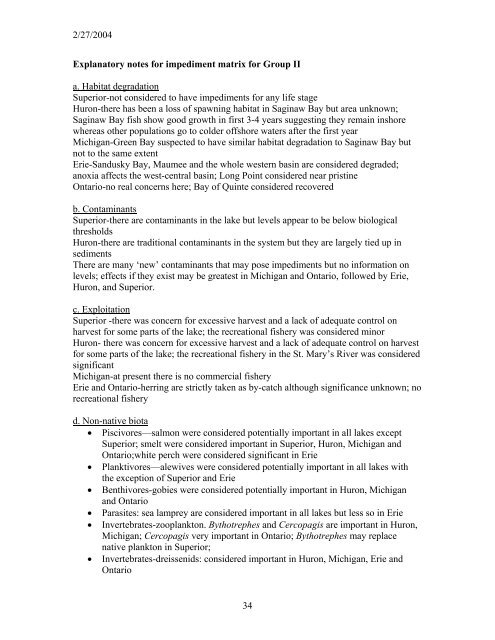Status and assessment, research, and restoration needs for lake ...
Status and assessment, research, and restoration needs for lake ...
Status and assessment, research, and restoration needs for lake ...
Create successful ePaper yourself
Turn your PDF publications into a flip-book with our unique Google optimized e-Paper software.
2/27/2004<br />
Explanatory notes <strong>for</strong> impediment matrix <strong>for</strong> Group II<br />
a. Habitat degradation<br />
Superior-not considered to have impediments <strong>for</strong> any life stage<br />
Huron-there has been a loss of spawning habitat in Saginaw Bay but area unknown;<br />
Saginaw Bay fish show good growth in first 3-4 years suggesting they remain inshore<br />
whereas other populations go to colder offshore waters after the first year<br />
Michigan-Green Bay suspected to have similar habitat degradation to Saginaw Bay but<br />
not to the same extent<br />
Erie-S<strong>and</strong>usky Bay, Maumee <strong>and</strong> the whole western basin are considered degraded;<br />
anoxia affects the west-central basin; Long Point considered near pristine<br />
Ontario-no real concerns here; Bay of Quinte considered recovered<br />
b. Contaminants<br />
Superior-there are contaminants in the <strong>lake</strong> but levels appear to be below biological<br />
thresholds<br />
Huron-there are traditional contaminants in the system but they are largely tied up in<br />
sediments<br />
There are many ‘new’ contaminants that may pose impediments but no in<strong>for</strong>mation on<br />
levels; effects if they exist may be greatest in Michigan <strong>and</strong> Ontario, followed by Erie,<br />
Huron, <strong>and</strong> Superior.<br />
c. Exploitation<br />
Superior -there was concern <strong>for</strong> excessive harvest <strong>and</strong> a lack of adequate control on<br />
harvest <strong>for</strong> some parts of the <strong>lake</strong>; the recreational fishery was considered minor<br />
Huron- there was concern <strong>for</strong> excessive harvest <strong>and</strong> a lack of adequate control on harvest<br />
<strong>for</strong> some parts of the <strong>lake</strong>; the recreational fishery in the St. Mary’s River was considered<br />
significant<br />
Michigan-at present there is no commercial fishery<br />
Erie <strong>and</strong> Ontario-herring are strictly taken as by-catch although significance unknown; no<br />
recreational fishery<br />
d. Non-native biota<br />
• Piscivores—salmon were considered potentially important in all <strong>lake</strong>s except<br />
Superior; smelt were considered important in Superior, Huron, Michigan <strong>and</strong><br />
Ontario;white perch were considered significant in Erie<br />
• Planktivores—alewives were considered potentially important in all <strong>lake</strong>s with<br />
the exception of Superior <strong>and</strong> Erie<br />
• Benthivores-gobies were considered potentially important in Huron, Michigan<br />
<strong>and</strong> Ontario<br />
• Parasites: sea lamprey are considered important in all <strong>lake</strong>s but less so in Erie<br />
• Invertebrates-zooplankton. Bythotrephes <strong>and</strong> Cercopagis are important in Huron,<br />
Michigan; Cercopagis very important in Ontario; Bythotrephes may replace<br />
native plankton in Superior;<br />
• Invertebrates-dreissenids: considered important in Huron, Michigan, Erie <strong>and</strong><br />
Ontario<br />
34
















